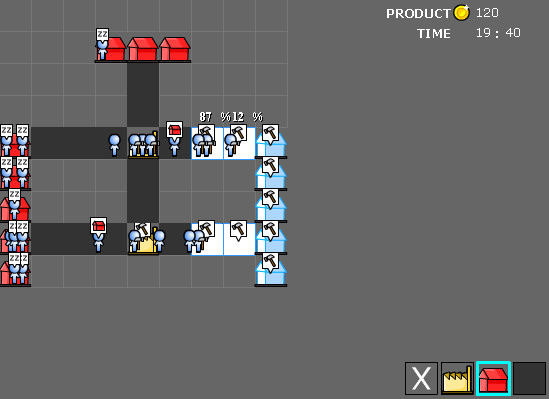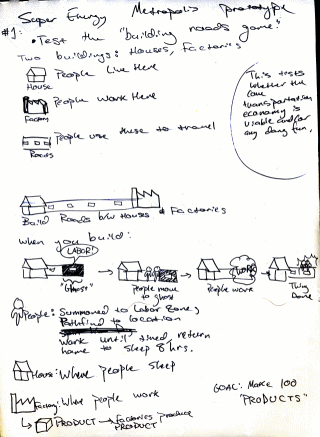Super Energy Metropolis Prototype 1
And thus starts the development blog for Super Energy Apocalypse's sequel. After some talks with my boss, we finally decided to go with a game idea called "Super Energy Metropolis" as our new game project. The basic idea is this:
Similar to Super Energy Apocalypse, but on a city-wide scale. Now instead of trying to carve out an individual little survivalist base, you're trying to rebuild civilization proper.
Sneak peek of where this is going:
 |
| Read this post to learn more and play this prototype! |
Whereas SEA's focus was mostly on power plants and fuel sources, SEM's focus will be squarely on Transportation. Our first principles are as such:
- Game should teach players about TRANSPORTATION
- Game should teach players about energy economy
- Game should teach players about pollution sources
- Emphasis on macro-management, not micro-management
- Emphasis on strategy, not tactics
With Number 1 being our biggest priority. So, to start with, I was inspired by Daniel Cook's quick-and-dirty Post-it note design docs approach.
The gist of it is this: You scribble down your ideas on a Post-it note (this is to force you to keep it short), build it, and see if its fun. There's only enough room to write a small amount, so you are only going to test one mechanic at a time this way.
So, the first and biggest question on my mind was : how are we going to cover transportation in Metropolis? In Apocalypse we automated all the garbage trucks and engineer vehicles - their AI sucked, but it kept the player from having to babysit the workers in his economy, something that endlessly annoyed me in games like StarCraft.
The first principles of this prototype are a sub-set of the entire project. We are trying to figure out how to accomplish two things:
- De-emphasize micro-management. The city "runs itself," with you making big decisions.
- Model transportation in a way that models real-world problems to the player clearly.
This prototype is only dealing with things on a totally miniscule level with tons of huge hand-wavy abstractions. We don't care about food, energy, building costs, any of that yet. We're just trying to model a basic, basic economy and transportation game and see if that is fun, because what we settle on at this stage will be the core of the game. We want to find something fun that says some real things about the way these problems are in real life, and move on from there, adding both fun, as well as more accurate real-world content.
So, adhering to the post-it note idea a bit loosely, I scribbled my thoughts down in big handwriting on a single page of my sketchbook:
 |
| Click to see full version |
Since not all of you will be able to read my fabulously legible hand-writing, the goal of the prototype game is to create a workable city which has four elements:
- Houses
- Factories
- Roads
- People
And then make that thing run really efficiently so as to maximize your output of "Product." There's no victory condition or anything, just play with it and see what happens.
The game has the following rules:
Houses:
- When a house is built, it is instantly populated by 3 new people
- People will leave their homes to work, and return to sleep.
- People will ONLY go back to the house they originally came from.
- Each house can accommodate 3 units of people.
- A new house takes 24 man-hours of work to build.
Factories:
- A factory that has no people in it will call on any nearby people to work there.
- Factory workers will produce "product" at a rate of 1 product per man-hour of work.
- A factory can accommodate 3 workers at a time.
- A new factory takes 24 man-hours of work to build.
Roads:
- Roads take 8 man-hours of work to build.
- People travel twice as fast across roads as they do "dirt" (unoccupied space).
- People travel at the same rate of speed across buildings as they do roads.
People:
- People begin as "idle" and wait for work to summon them.
- People path find to their summoned work location, taking the shortest route there.
- People will seek out work and work for 8 hours. If they finish a job before then, they will continue working until they have worked for a full 8 hours.
- After working, a person will pathfind home and sleep for 8 hours, then seek work again.
Other Stuff:
- There is a clock that keeps track of time, it counts up from 00:00 to 23:59 and then resets.
- There is a "product" count. The ostensible goal of this prototype is to see how quickly you can produce "product."
- To build something, the user clicks on a button, then somewhere on the map, and a "ghost" appears. Up to 3 workers move to that location and work until it is finished or until they have finished their daily work quota.
I think better in pictures so you can see why the diagram was easier for me than spelling out all these rules. I came up with most of these rules as a way to implement the above diagram when I set out to program this thing.
I worked on it until the early morning hours one night, and was pleased with the results. Here it is!
 |
| Click the image to play! |
I've already gotten an assessment of the prototype, which I'll follow up about in the next post.
Edit: Here's the results!